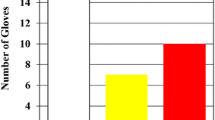Abstract
Cutting injuries and needle-stitch injuries constitute a potentially fatal danger to both pathologists and autopsy personnel. We evaluated such injuries in a large German institute of pathology from 2002 to 2007 and analysed the effect of the introduction of cut-resistant gloves on the incidence of these injuries. In the observation period, 64 injuries (48 cutting injuries and 16 needle-stitch injuries) were noted in the injury report books. Most injuries were located at the non-dominant hand, preferentially at the index finger and the thumb. Around one fifths of the injuries were at the side of handedness. The average number of injuries per month was 1.22 for the 50months prior to the introduction of cut-resistant gloves, more than seven times higher than after their introduction (0.158; 19months; p < 0.001). Considering the medical and administrational costs of such injuries, cut-resistant protective gloves are an effective and cost-effective completion of personal occupational safety measures in surgical pathology and autopsy. We strongly recommend the use of such gloves, especially for autopsy personnel.



Similar content being viewed by others
References
Alter MJ (2007) Epidemiology of hepatitis C virus infection. World J Gastroenterol 13:2436–2441
Aoki M (2004) Transmission of tuberculosis (II). Kekkaku 79:693–703
Bellentani S, Miglioli L, Bedogni G, Croce LS, Tiribelli C (2005) Epidemiology of hepatitis C virus infection. Minerva Gastroenterol Dietol 51:15–29
Best M, Neuhauser D (2004) Ignaz Semmelweis and the birth of infection control. Qual Saf Health Care 13:233–234
Burton JL (2003) Health and safety at necropsy. J Clin Pathol 56:254–260
Cone LA, Curry N, Wuestoff MA, O, ’ SJ, Feller JF (1998) Septic synovitis and arthritis due to Corynebacterium striatum following an accidental scalpel injury. Clin Infect Dis 27:1532–1533
De Costa CM (2002) "The contagiousness of childbed fever": a short history of puerperal sepsis and its treatment. Med J Aust 177:668–671
Ganczak M, Boron-Kaczmarska A, Dziuba I (2003) Pathologist and HIV—are safe autopsies possible? Pol J Pathol 54:143–146
Gerston KF, Blumberg L, Gafoor H (1998) Viability of mycobacteria in formalin-fixed tissues. Int J Tuberc Lung Dis 2:521
Gerston KF, Blumberg L, Tshabalala VA, Murray J (2004) Viability of mycobacteria in formalin-fixed lungs. Human Pathol 35:571–575
Hamouda O, Marcus U, Voss L, Kollan C (2007) Epidemiology of HIV infections in Germany. Bundesgesundheitsblatt Gesundheitsforschung Gesundheitsschutz 50:399–411
Ippolito G, The Studio Italiano Rischio O (1996) Scalpel injury and HIV infection in a surgeon. The Studio Italiano Rischio Occupazionale da HIV (SIROH). Lancet 347:1042
Johnson MD, Schaffner W, Atkinson J, Pierce MA (1997) Autopsy risk and acquisition of human immunodeficiency virus infection: a case report and reappraisal. Arch Pathol Lab Med 121:64–66
Kelly KE, Lee KC, Tami TA (1993) Surgical glove perforations in otolaryngology: prevention with cut-resistant gloves. Otolaryngol Head Neck Surg 108:91–95
Lewis FR Jr., Short LJ, Howard RJ, Jacobs AJ, Roche NE (1995) Epidemiology of injuries by needles and other sharp instruments. Minimizing sharp injuries in gynecologic and obstetric operations. Surg Clin North Am 75:1105–1121
Louis SS, Steinberg EL, Gruen OA, Bartlett CS, Helfet DL (1998) Outer gloves in orthopaedic procedures: a polyester/stainless steel wire weave glove liner compared with latex. J Orthop Trauma 12:101–105
Nolte KB, Yoon SS (2003) Theoretical risk for occupational blood-borne infections in forensic pathologists. Infect Control Hosp Epidemiol 24:772–773
Okochi Y (2005) Hospital outbreak of Mycobacterium tuberculosis resulting from autopsy exposure. Kansenshogaku Zasshi 79:534–542
Paul N, Jacob ME (2006) An outbreak of cadaver-acquired chickenpox in a health care setting. Clin Infect Dis 43:599–601
Pieper SP, Schimmele SR, Johnson JA, Harper JL (1995) A prospective study of the efficacy of various gloving techniques in the application of Erich arch bars. J Oral Maxillofac Surg 53:1174–1176 discussion 1177
Pritt BS, Waters BL (2005) Cutting injuries in an academic pathology department. Arch Pathol Lab Med 129:1022–1026
Steger G (1987) Life expectancy and causes of death of pathologists. Pathologe 8:108–111
Sutton PM, Greene T, Howell FR (1998) The protective effect of a cut-resistant glove liner. A prospective, randomised trial. J Bone Joint Surg 80:411–413
Walls T, Shingadia D (2007) The epidemiology of tuberculosis in Europe. Arch Dis Child 92:726–729
Wang JF, Cao Z, Chen XS (2004) The advance of protection for hazard factor during autopsy. Fa Yi Xue Za Zhi 20:110–112
Woods JA, Leslie LF, Drake DB, Edlich RF (1996) Effect of puncture resistant surgical gloves, finger guards, and glove liners on cutaneous sensibility and surgical psychomotor skills. J Biomed Mater Res 33:47–51
Yazdanpanah Y, De Carli G, Migueres B, Lot F, Campins M, Colombo C, Thomas T, Deuffic-Burban S, Prevot MH, Domart M, Tarantola A, Abiteboul D, Deny P, Pol S, Desenclos JC, Puro V, Bouvet E (2005) Risk factors for hepatitis C virus transmission to health care workers after occupational exposure: a European case-control study. Clin Infect Dis 41:1423–1430
Acknowledgements
The support in financial data collection by the Unfallkasse Berlin, Unfallkasse München and Unfallkasse Nordrhein-Westfalen is greatly acknowledged. We thank our chief autopsy assistants Mr. Rudi Schweiger and Mr. Anistan Sebastiampillai for their continuous support and Dr. Marius Fritzsche for discussion.
Conflict of interest statement
We declare that we have no conflict of interest.
Author information
Authors and Affiliations
Corresponding author
Rights and permissions
About this article
Cite this article
Fritzsche, F.R., Dietel, M., Weichert, W. et al. Cut-resistant protective gloves in pathology—effective and cost-effective. Virchows Arch 452, 313–318 (2008). https://doi.org/10.1007/s00428-008-0576-y
Received:
Revised:
Accepted:
Published:
Issue Date:
DOI: https://doi.org/10.1007/s00428-008-0576-y




